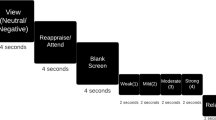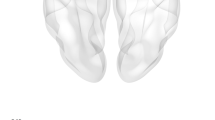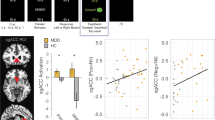Abstract
Depression has been associated with changes in responses within the medial prefrontal cortex (mPFC) during emotional information processing. Antidepressant drug treatment has been shown to modify neural responses in healthy volunteers early in treatment within similar circuitry. It is unclear, however, whether the same early effect occurs in depressed patients, before changes in mood. The current study therefore investigated the effects of 7-days administration of the selective serotonin-uptake inhibitor citalopram vs placebo in volunteers (n=29) at a high risk for the development of depression, using the personality phenotype of high neuroticism in a double-blind, between-groups design. On the last day of treatment, resting haemoperfusion and functional magnetic resonance imaging (MRI) data were acquired during a self-referential words categorisation task. A significant activation in a cluster of mPFC areas, including dorsal anterior cingulate and right orbitofrontal cortex was revealed, driven by decreased responses to the negative self-descriptors following citalopram compared with placebo, in the absence of any mood differences. These findings show a normalisation of neural abnormalities in- and at-risk population early in treatment, supporting the theory that antidepressants may indeed act by modifying specific neural dysfunctions correlated to negative cognitive biases.
This is a preview of subscription content, access via your institution
Access options
Subscribe to this journal
Receive 12 print issues and online access
$259.00 per year
only $21.58 per issue
Buy this article
- Purchase on Springer Link
- Instant access to full article PDF
Prices may be subject to local taxes which are calculated during checkout


Similar content being viewed by others
References
Price JL, Drevets WC . Neurocircuitry of mood disorders. Neuropsychopharmacology 2010; 35: 192–216.
Phillips ML, Drevets WC, Rauch SL, Lane R . Neurobiology of emotion perception I: the neural basis of normal emotion perception. Biol Psychiatry 2003; 54: 504–514.
Phan KL, Wager T, Taylor SF, Liberzon I . Functional neuroanatomy of emotion: a meta-analysis of emotion activation studies in PET and fMRI. Neuroimage 2002; 16: 331–348.
Rolls ET, Grabenhorst F . The orbitofrontal cortex and beyond: from affect to decision-making. Prog Neurobiol 2008; 86: 216–244.
Ochsner KN, Gross JJ . The cognitive control of emotion. Trends Cogn Sci 2005; 9: 242–249.
Leppanen JM . Emotional information processing in mood disorders: a review of behavioral and neuroimaging findings. Curr Opin Psychiatry 2006; 19: 34–39.
Bradley BP, Mogg K, Millar N . Implicit memory bias in clinical and non-clinical depression. Behav Res Ther 1996; 34: 865–879.
Fu CH, Williams SC, Cleare AJ, Scott J, Mitterschiffthaler MT, Walsh ND et al. Neural responses to sad facial expressions in major depression following cognitive behavioral therapy. Biol Psychiatry 2008; 64: 505–512.
Yoshimura S, Okamoto Y, Onoda K, Matsunaga M, Ueda K, Suzuki S et al. Rostral anterior cingulate cortex activity mediates the relationship between the depressive symptoms and the medial prefrontal cortex activity. J Affect Disord 2010; 122: 76–85.
Beck AT . The evolution of the cognitive model of depression and its neurobiological correlates. Am J Psychiatry 2008; 165: 969–977.
Davidson RJ, Irwin W, Anderle MJ, Kalin NH . The neural substrates of affective processing in depressed patients treated with venlafaxine. Am J Psychiatry 2003; 160: 64–75.
Chen CH, Suckling J, Ooi C, Fu CH, Williams SC, Walsh ND et al. Functional coupling of the amygdala in depressed patients treated with antidepressant medication. Neuropsychopharmacology 2008; 33: 1909–1918.
Mayberg HS, Brannan SK, Tekell JL, Silva JA, Mahurin RK, McGinnis S et al. Regional metabolic effects of fluoxetine in major depression: serial changes and relationship to clinical response. Biol Psychiatry 2000; 48: 830–843.
Fu CH, Williams SC, Cleare AJ, Brammer MJ, Walsh ND, Kim J et al. Attenuation of the neural response to sad faces in major depression by antidepressant treatment: a prospective, event-related functional magnetic resonance imaging study. Arch Gen Psychiatry 2004; 61: 877–889.
Eugene F, Joormann J, Cooney RE, Atlas LY, Gotlib IH . Neural correlates of inhibitory deficits in depression. Psychiatry Res 2010; 181: 30–35.
Pardo JV, Sheikh SA, Schwindt GC, Lee JT, Kuskowski MA, Surerus C et al. Chronic vagus nerve stimulation for treatment-resistant depression decreases resting ventromedial prefrontal glucose metabolism. Neuroimage 2008; 42: 879–889.
Mayberg HS, Lozano AM, Voon V, McNeely HE, Seminowicz D, Hamani C et al. Deep brain stimulation for treatment-resistant depression. Neuron 2005; 45: 651–660.
Goldapple K, Segal Z, Garson C, Lau M, Bieling P, Kennedy S et al. Modulation of cortical-limbic pathways in major depression: treatment-specific effects of cognitive behavior therapy. Arch Gen Psychiatry 2004; 61: 34–41.
Dichter GS, Felder JN, Smoski MJ . The effects of Brief Behavioral Activation Therapy for Depression on cognitive control in affective contexts: an fMRI investigation. J Affect Disord 2010; 126: 236–244.
Harmer CJ . Serotonin and emotional processing: does it help explain antidepressant drug action? Neuropharmacology 2008; 55: 1023–1028.
Harmer CJ, Cowen PJ, Goodwin GM . Efficacy markers in depression. J Psychopharmacol 8 June 2010; e-pub ahead of print.
Harmer CJ, Mackay CE, Reid CB, Cowen PJ, Goodwin GM . Antidepressant drug treatment modifies the neural processing of nonconscious threat cues. Biol Psychiatry 2006; 59: 816–820.
Norbury R, Taylor MJ, Selvaraj S, Murphy SE, Harmer CJ, Cowen PJ . Short-term antidepressant treatment modulates amygdala response to happy faces. Psychopharmacology (Berl) 2009; 206: 197–204.
Murphy SE, Norbury R, O’Sullivan U, Cowen PJ, Harmer CJ . Effect of a single dose of citalopram on amygdala response to emotional faces. Br J Psychiatry 2009; 194: 535–540.
Norbury R, Mackay CE, Cowen PJ, Goodwin GM, Harmer CJ . The effects of reboxetine on emotional processing in healthy volunteers: an fMRI study. Mol Psychiatry 2008; 13: 1011–1020.
Kendler KS, Gatz M, Gardner CO, Pedersen NL . Personality and major depression: a Swedish longitudinal, population-based twin study. Arch Gen Psychiatry 2006; 63: 1113–1120.
Kendler KS, Myers J . The genetic and environmental relationship between major depression and the five-factor model of personality. Psychol Med 2010; 40: 801–806.
Chan SW, Goodwin GM, Harmer CJ . Highly neurotic never-depressed students have negative biases in information processing. Psychol Med 2007; 37: 1281–1291.
Chan SW, Harmer CJ, Goodwin GM, Norbury R . Risk for depression is associated with neural biases in emotional categorisation. Neuropsychologia 2008; 46: 2896–2903.
Canli T . Toward a neurogenetic theory of neuroticism. Ann N Y Acad Sci 2008; 1129: 153–174.
Haas BW, Constable RT, Canli T . Stop the sadness: Neuroticism is associated with sustained medial prefrontal cortex response to emotional facial expressions. Neuroimage 2008; 42: 385–392.
Eysenck SBG, Eysenck HJ . Manual of the EPQ (Eysenck Personality Questionnaire). University of London Press: London, 1975.
Spitzer RL, Williams G, Gibbon M . Structured Clinical Interview for the DSM-IV. New York State Psychiatric Institute: New York, 2002.
Spielberger CD, Gorsuch R, Lushene RD . Manual for the State-Trait Anxiety Inventory (STAI). Consulting Psychologists Press: Palo Alto, CA, 1983.
Beck AT, Ward CH, Mendelson M, Mock J, Erbaugh J . An inventory for measuring depression. Arch Gen Psychiatry 1961; 4: 561–571.
Weisman AN, Beck AT . Development and validation of the Dysfunctional Attitudes Scale: A preliminary investigation. American Education Research Association: Toronto, Canada, 1978.
Goodyer IM, Herbert J, Tamplin A, Secher SM, Pearson J . Short-term outcome of major depression: II. Life events, family dysfunction, and friendship difficulties as predictors of persistent disorder. J Am Acad Child Adolesc Psychiatry 1997; 36: 474–480.
von Zerssen D, Strian F, Schwarz D . Evaluation of depressive states, especially in longitudinal studies. Mod Probl Pharmacopsychiatry 1974; 7: 189–202.
Anderson N . Likeableness ratings of 555 personality-trait words. J Pers Soc Psychol 1968; 9: 272–279.
Francis W, Kucera A . Frequency Analysis of English Usage: Lexicon and Grammar. Houghton Mifflin: Boston, MA, 1982.
Harmer CJ, Shelley NC, Cowen PJ, Goodwin GM . Increased positive versus negative affective perception and memory in healthy volunteers following selective serotonin and norepinephrine reuptake inhibition. Am J Psychiatry 2004; 161: 1256–1263.
Miskowiak K, Papadatou-Pastou M, Cowen PJ, Goodwin GM, Norbury R, Harmer CJ . Single dose antidepressant administration modulates the neural processing of self-referent personality trait words. Neuroimage 2007; 37: 904–911.
MacIntosh BJ, Pattinson KTS, Gallichan D, Ahmad I, Miller KL, Feinberg DA et al. Measuring the effects of remifentanil on cerebral blood flow and arterial arrival time using 3D GRASE MRI with pulsed arterial spin labelling. J Cereb Blood Flow Metab 2008; 28: 1514–1522.
Smith SM, Jenkinson M, Woolrich MW, Beckmann CF, Behrens TE, Johansen-Berg H et al. Advances in functional and structural MR image analysis and implementation as FSL. Neuroimage 2004; 23 (Suppl 1): S208–S219.
Jenkinson M, Bannister P, Brady M, Smith SM . Improved optimisation for the robust and accurate linear registration and motion correction of brain images. Neuroimage 2002; 17: 825–841.
Smith S . Fast and robust automated brain extraction. Hum Brain Mapp 2002; 17: 143–155.
Beckmann CF, Smith SM . Probabilistic independent component analysis for functional magnetic resonance imaging. IEEE Trans on Med Imaging 2004; 23: 137–152.
Woolrich MW, Ripley BD, Brady M, Smith SM . Temporal autocorrelation in univariate linear modeling of FMRI data. Neuroimage 2001; 14: 1370–1386.
Woolrich MW, Behrens TE, Beckmann CF, Jenkinson M, Smith SM . Multilevel linear modelling for FMRI group analysis using Bayesian inference. Neuroimage 2004; 21: 1732–1747.
Friston K, Worsley KJ, farckowiak RSJ, Mazziotta JC, Evans AC . Assessing the significance of focal activations using their spatial extent. Hum Brain Mapp 1994; 1: 210–220.
Talaraich J, Tournoux P . Co-planar stereotaxic atlas of the human brain: three-dimensional proportional system. Thieme Medical, New York, 1988.
Chappell MA, Okell TW, Jezzard P, Woolrich MW . Vascular territory image analysis using vessel encoded arterial spin labeling. Med Image Comput Comput Assist Interv 2009; 12 (Part 2): 514–521.
Nichols TE, Holmes AP . Nonparametric permutation tests for functional neuroimaging: a primer with examples. Hum Brain Mapp 2002; 15: 1–25.
Rudebeck PH, Bannerman DM, Rushworth MF . The contribution of distinct subregions of the ventromedial frontal cortex to emotion, social behavior, and decision making. Cogn Affect Behav Neurosci 2008; 8: 485–497.
Carmichael ST, Price JL . Sensory and premotor connections of the orbital and medial prefrontal cortex of macaque monkeys. J Comp Neurol 1995; 363: 642–664.
Bush G, Luu P, Posner MI . Cognitive and emotional influences in anterior cingulate cortex. Trends Cogn Sci 2000; 4: 215–222.
Haas BW, Omura K, Constable RT, Canli T . Emotional conflict and neuroticism: personality-dependent activation in the amygdala and subgenual anterior cingulate. Behav Neurosci 2007; 121: 249–256.
Mannie ZN, Norbury R, Murphy SE, Inkster B, Harmer CJ, Cowen PJ . Affective modulation of anterior cingulate cortex in young people at increased familial risk of depression. Br J Psychiatry 2008; 192: 356–361.
Gotlib IH, Hamilton JP, Cooney RE, Singh MK, Henry ML, Joormann J . Neural processing of reward and loss in girls at risk for major depression. Arch Gen Psychiatry 2010; 67: 380–387.
Longe O, Maratos FA, Gilbert P, Evans G, Volker F, Rockliff H et al. Having a word with yourself: neural correlates of self-criticism and self-reassurance. Neuroimage 2010; 49: 1849–1856.
Eugene F, Levesque J, Mensour B, Leroux JM, Beaudoin G, Bourgouin P et al. The impact of individual differences on the neural circuitry underlying sadness. Neuroimage 2003; 19 (2 Part 1): 354–364.
Ochsner KN, Ray RD, Cooper JC, Robertson ER, Chopra S, Gabrieli JD et al. For better or for worse: neural systems supporting the cognitive down- and up-regulation of negative emotion. Neuroimage 2004; 23: 483–499.
Cunningham WA, Raye CL, Johnson MK . Implicit and explicit evaluation: FMRI correlates of valence, emotional intensity, and control in the processing of attitudes. J Cogn Neurosci 2004; 16: 1717–1729.
Raichle ME, Snyder AZ . A default mode of brain function: a brief history of an evolving idea. Neuroimage 2007; 37: 1083–1090; discussion 97–9.
Sheline YI, Price JL, Yan Z, Mintun MA . Resting-state functional MRI in depression unmasks increased connectivity between networks via the dorsal nexus. Proc Natl Acad Sci USA 2010; 107: 11020–11025.
Sheline YI, Barch DM, Price JL, Rundle MM, Vaishnavi SN, Snyder AZ et al. The default mode network and self-referential processes in depression. Proc Natl Acad Sci USA 2009; 106: 1942–1947.
Lemogne C, Mayberg H, Bergouignan L, Volle E, Delaveau P, Lehericy S et al. Self-referential processing and the prefrontal cortex over the course of depression: a pilot study. J Affect Disord 2010; 124: 196–201.
Grimm S, Ernst J, Boesiger P, Schuepbach D, Hell D, Boeker H et al. Increased self-focus in major depressive disorder is related to neural abnormalities in subcortical-cortical midline structures. Hum Brain Mapp 2009; 30: 2617–2627.
Papageorgiou C, Wells A (eds). Depressive ruminatio: nature, theory and treatment. John Wiley and Sons: West Sussex, 2004.
Harmer CJ, Goodwin GM, Cowen PJ . Why do antidepressants take so long to work? A cognitive neuropsychological model of antidepressant drug action. Br J Psychiatry 2009; 195: 102–108.
Rawlings N, Norbury R, Cowen PJ, Harmer CJ . A single dose of mirtazapine modulates neural responses to emotional faces in healthy people. Psychopharmacology (Berl) 2010; 212: 625–634.
Harmer CJ, O’Sullivan U, Favaron E, Massey-Chase R, Ayres R, Reinecke A et al. Effect of acute antidepressant administration on negative affective bias in depressed patients. Am J Psychiatry 2009; 166: 1178–1184.
Acknowledgements
The study was supported by a Medical Research Council grant to Dr Catherine Harmer.
Author information
Authors and Affiliations
Corresponding author
Ethics declarations
Competing interests
MD and RN report no conflicts of interest. CJH has served as a consultant for P1vital, GlaxoSmithKline, Servier, Astra Zeneca, Johnson & Johnson, Lundbeck and is on the advisory board and holds shares of P1vital.
Additional information
Supplementary Information accompanies the paper on the Molecular Psychiatry website
Supplementary information
PowerPoint slides
Rights and permissions
About this article
Cite this article
Di Simplicio, M., Norbury, R. & Harmer, C. Short-term antidepressant administration reduces negative self-referential processing in the medial prefrontal cortex in subjects at risk for depression. Mol Psychiatry 17, 503–510 (2012). https://doi.org/10.1038/mp.2011.16
Received:
Revised:
Accepted:
Published:
Issue Date:
DOI: https://doi.org/10.1038/mp.2011.16
Keywords
This article is cited by
-
Network effects of Stanford Neuromodulation Therapy (SNT) in treatment-resistant major depressive disorder: a randomized, controlled trial
Translational Psychiatry (2023)
-
How do Mindfulness-Based Programs Improve Depression Symptoms: Selflessness, Valence, or Valenced Self?
Cognitive Therapy and Research (2022)
-
The effects of FAAH inhibition on the neural basis of anxiety-related processing in healthy male subjects: a randomized clinical trial
Neuropsychopharmacology (2021)
-
Prefrontal TDCS attenuates medial prefrontal connectivity upon being criticized in individuals scoring high on perceived criticism
Brain Imaging and Behavior (2019)
-
Differential effects of antidepressant treatment on long-range and short-range functional connectivity strength in patients with major depressive disorder
Scientific Reports (2017)



